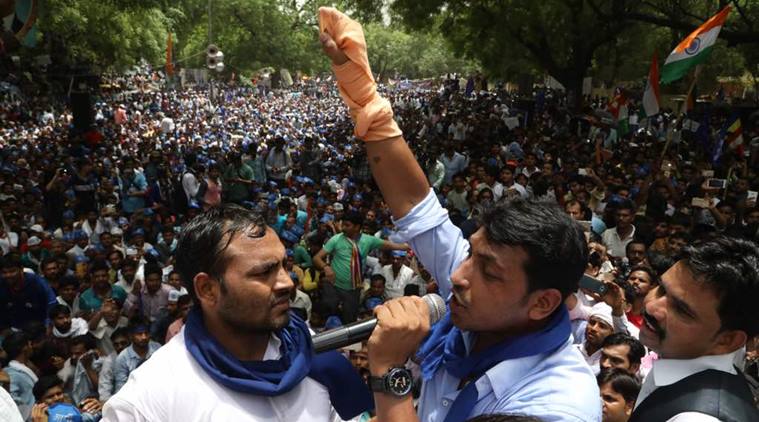India’s new Dalit icon
May 24, 2017 | Expert Insights

On 21st May 2017, thousands of Dalits gathered at Jantar Mantar in Delhi to protest the anti-Dalit violence in the northern town of Saharanpur.
Saharanpur violence
On 19th May Saharanpur witnessed violent caste clashes after members of the Thakur community who had initiated a procession to commemorate the birth anniversary of Maharana Pratap. The Dalits protested against the parade passing through their village which led to full blown clash between both the groups which resulted in the death of a young Dalit and at least 12 Dalit’s houses were set on fire.
The new Dalit icon
The clash between Dalits and Thakurs in Uttar Pradesh’s Saharanpur has become a major controversy. Thousands of people wearing blue cloth caps held a demonstration at Jantar Mantar to protest the caste riots.
Mr Chandrashekhar, a 30 year old lawyer was the leader of the protest. He’s been wanted since the community members clashed with the police on 9th may. Until his appearance he had been communicating through audio messages asking his supporters to join the rally. His emergence as the new Dalit leader has marked a new beginning to Dalit politics in India. In 2015, he had formed the Bhim Army that works for Dalit’s emancipation through education. It runs many free schools for Dalit in western Uttar Pradesh.
Condition of Dalits in India
Even after 70 years of independence political rhetoric and constitutional protection have failed to end atrocities against Dalits. According to the NHRC report on atrocities against schedule caste a crime is committed against a Dalit every 18 minute and on an average three Dalit women are raped and two murdered almost every day. At least 37% of Dalits live below the poverty line and 45% remain illiterate.
Various laws were passed for the protection of Dalits. The protection of civil rights act, 1995 and the SC/ST (prevention of atrocities) Act, 1989 prescribed punishments from crimes against Dalits that are much more stringent than corresponding offences under IPC. Special courts have been established in major states for speedy trial of cases. In 2006, former Prime Minister Manmohan Singh even equated the practice of untouchability to apartheid in South Africa. In 2015, the SC and ST amendment bill was passed by the parliament that made several critical changes. Atrocities like preventing SC/ST from using common property resources and entering places of worship, educational and health institutions were added to the list of offences.
Despite these attempts violence against Dalits have increased. Rajasthan has the highest rate of atrocities committed against Dalits. The centre for Dalit rights in Jaipur stated that between April 2105 to march 2016 severe incidents of violence were registered. Most of the cases were related to land.
Assessment
Caste based violence has been going on for long in India. In spite of various protectionary laws, violation of Dalit rights has been a part of the society. This could invoke other cities to join the protest to finally take some stringent actions against such discrimination and violence. If the governments in the respective states and at the centre fail to address their issues, the Dalits could unite under one umbrella against the government.
This initiative by Chandrashekhar could also pose a threat to parties in power, primarily, BSP which represents Bahujans. He could soon become a popular figure to lead a Bahujan party which could in future bring about more protection of SC/ST.








Comments